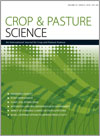This 7-year study examined soil carbon pools, aggregate stability, enzyme activities and wheat yield under conservation and conventional tillage and residue-management practices in a rice–wheat system on the Indo-Gangetic Plain. Macro-aggregates (>0.25 mm) had higher labile C pools, glomalin content and enzyme activities than micro-aggregates. The combination of no-till direct-seeded rice with no-till wheat + rice residue increased SOC, soil enzyme activities, aggregate stability and wheat grain yield, indicating that adoption of no till and residue retention may improve sustainability in these rice–wheat systems.

Crop and Pasture Science
Volume 70 Number 6 2019
CP18260Effects of short-term heat stress at booting stage on rice-grain quality

Short-term heat stress at booting significantly reduced grain size, chalky grain rate, milling quality and amylose content, but increased protein content. Severe heat stress at booting decreased values of peak viscosity and breakdown, and increased pasting temperature of rice. The impacts on rice grain quality could be quantified by the combined effects of the intensity and duration of heat stress at booting stage.
CP18393Impact of foliar and root application of phosphorus on zinc concentration of winter wheat grown in China
Understanding the interactions of P and foliar-applied Zn fertilisers could promote adoption of foliar Zn by growers. We investigated the effects of P applied to leaves or roots on Zn uptake in wheat and found that foliar Zn application, alone or in combination with P, significantly increased grain Zn concentration, and that P applied to leaves but not to roots inhibited the physiological availability of Zn in wheat tissues. These results improve mechanistic understanding of P–Zn interactions in plants and may improve Zn-biofortification efforts in wheat.
Quantitative trait loci (QTLs) for the textural properties of Chinese steamed bread were detected. Eighteen putative QTLs referring to six textural quality traits were detected on 14 chromosomes. The contributions of these QTLs ranged from 6.19% to 15.74%.
CP19042Potassium translocation combined with specific root uptake is responsible for the high potassium efficiency in vegetable soybean
 , Bingjie Tu, Xue Wang, Jian Jin, Yansheng Li, Qiuying Zhang, Xiaobing Liu and Baoluo Ma
, Bingjie Tu, Xue Wang, Jian Jin, Yansheng Li, Qiuying Zhang, Xiaobing Liu and Baoluo Ma
Breeding potassium (K)-efficient cultivars is of great importance for improving the efficiency of K-fertiliser utilisation. Genotypic variation exists for K-use efficiency in vegetable soybean, but the characteristics of high K-efficiency genotypes in vegetable soybean are still unclear. We found that high K-efficiency vegetable soybeans have higher K-redistribution capacity and strong specific root uptake rate, which could be used in breeding programs.
Are there any differences in nutrient composition between the crucial global transgenic, glyphosate-resistant soybeans and conventional Chinese soybeans? Our results indicated that transgenic soybeans had the highest oil concentration but poorer quality, whereas soybeans from the Huanghuaihai region of China had superior nutritional value in terms of protein, oil, amino acid and fatty acid composition. The results of this study can help to guide soybean processing and promote safety assessment of transgenic soybeans.
To test whether EBL could be used to increase tolerance to water deficits in common bean, the effects of EBL application on photosynthesis and gas-exchange parameters, seed yield, and protein content were studied. Improvement in seed and protein yields in both common bean genotypes due to foliar applied EBL was found to be associated with EBL induced enhancement in photosynthetic capacity. Applying 4 µM EBL as a foliar spray might be a useful practice for the production of common beans.
Is it possible to locate plants with a desired trait without performing any field or lab trial? As cyanoglucosides, which are toxic for cattle, may be present in white clover, we successfully applied a method to find cyanoglucoside-free white clover populations based on a previous association between the presence of this compound and certain environmental conditions. The potential to predict traits using this method may encourage greater investment in forage plant breeding and boost utilisation of seeds preserved in genebanks.
CP18346 Abstract | CP18346 Full Text | CP18346PDF (409 KB) Open Access Article
CP18569Elevated CO2 causes large changes to morphology of perennial ryegrass (Lolium perenne)
Plant morphology is particularly important for agricultural species because economically important traits are linked to simple features such as blade length and plant height. We tested the combined effects of elevated CO2 and water supply on morphological traits of Lolium perenne and found that sizes of leaves and individual tillers were dramatically smaller in plants grown at elevated CO2, independent of water supply. This will have important implications for selective breeding and pasture productivity under future conditions.



